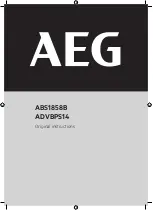
SB-2-614-C Page 3
Air Cap (Ref. No. 2)
Fluid Tip Size
Part No.
Application
Spray Gun Model No.
Supplied with Gun
FLG-1-1
Conventional FLG-695-113 Conventional
1.3 mm
FLG-1-3
HVLP
FLG-691-315 HVLP
1.5 mm & 1.8 mm
Chart 1 – Air Caps
If the finish is too sandy and dry, the
material flow may be too low for the
atomization air pressure being used.
Turn the fluid needle adjusting knob (14)
counterclockwise to increase fluid flow.
If the finish sags, there is too much mate-
rial flowing for the atomization air pressure
being used. Turn the fluid needle adjusting
knob (14) clockwise to decrease fluid flow.
Pattern width can be altered by turning
spreader adjustment valve (8), either
clockwise to decrease the width or counter-
clockwise to increase the width.
Adjust inlet air pressure to provide a uniform
dispersion of atomized paint throughout
the pattern. Keep air pressure as low as
possible to minimize bounce-back and
overspray. Excessive pressure will result in
split spray patterns. Inadequate pressures
will cause heavy centered patterns and poor
atomization.
CLEANING
Note
For routine cleaning, it is not neces-
sary to remove cup from gun. Do
not remove washer (7) from gun.
If washer (7) is removed, it must
be replaced.
Do not soak the lid in solvent for
extended periods of time. Doing
so could cause cup/lid sealing
problems and leakage.
The cup lid is designed to be disposable
but may be cleaned and reused if slight-
ly contaminated with overspray. If lid
becomes tight, or does not fit, it is due
to extended soaking in solvent. Let lid air
dry overnight and the lid should return to
its original size and fit.
Remove lid and properly dispose of any
excess paint. Pour in a small amount of
clean solvent. The amount will vary with
different coatings and solvents. Reinstall
lid. Shake cup to wash down the inside
surfaces. Hold lid while shaking to prevent
lid from coming off. Pull trigger to allow
some solvent to be flushed through gun.
Remove lid and pour out dirty solvent. Add
a small amount of clean solvent and repeat
procedure. Wipe exterior of lid with a clean
cloth and clean solvent.
If a paint filter was used in the bottom of
the cup outlet, it should be removed and
cleaned or replaced at this time. Dispose
of used cup lid if contaminated and replace
with new.
To clean air cap and fluid tip, brush exterior
with a stiff bristle brush. If necessary to clean
cap holes, use a broom straw or toothpick
if possible. If a wire or hard instrument is
used, extreme care must be used to prevent
scratching or burring of the holes which will
cause a distorted spray pattern.
To clean fluid passages, remove excess
material at source, then flush with a suitable
solvent. Wipe gun exterior with a solvent
dampened cloth. Never completely im-
merse in solvent as this is detrimental to
the lubricants and packings.
PREVENTIVE MAINTENANCE
Spray Gun Lubrication
Daily, apply a drop of SSL-10 spray gun
lube at trigger bearing stud (22) and the
stem of the air valve (15). The shank of the
fluid needle (12) where it enters the pack-
ing nut (25) should also be oiled. The fluid
needle packing (24) should be kept soft and
pliable by periodic lubrication. Make sure
the baffle (6) and retaining ring (1) threads
are clean and free of foreign matter. Before
assembling retaining ring to baffle, clean the
threads thoroughly, then add two drops of
SSL-10 spray gun lube to threads. The fluid
needle spring (13) and air valve spring (16)
should be coated with a very light grease,
making sure that any excess grease will
not clog the air passages. For best results,
lubricate the points indicated, daily.
A. Trigger Points
B. Packing
C. Adjusting Valves
D. Baffle/Air Cap Threads
PARTS REPLACEMENT
Note
When replacing the fluid tip or
fluid needle, replace both at the
same time. Using worn parts can
cause fluid leakage. Also, replace
the needle packing and fluid tip
seal at this time. Lightly lubricate
the threads of the fluid tip before
reassembling. Torque to 15-20 ft-
lbs. Do not overtighten the fluid tip.
The tip size is stamped on the hex of the
fluid tip (#3). The fluid tip part number and
tip size are also stamped around the outside
of the fluid tip.
See Chart 1 for selecting the proper size
fluid tip for the material you are spraying.
To prevent damage to the fluid tip (3)
or fluid needle (12), be sure to either
1) pull the trigger and hold while
tightening or loosening the fluid
tip or 2) remove fluid needle ad-
justing screw (14) to relieve spring
pressure against needle collar.
A
B
C
D
Fluid Tip & Seal
Fluid Tip Fluid Tip
(Ref. No. 5)
Size
Size
Part No.
(in.)
(mm)
Applications
FLG-302-13K
0.051
1.3
Stains, lacquers, basecoats, clears.
FLG-302-15K
0.059
1.5
General purpose, light to medium viscosity material.
FLG-302-18K
0.070
1.8
Primers and medium viscosity materials.
FLG-302-22K
0.086
2.2
Light to medium viscosity materials.
Chart 2 – Fluid Tips
Inlet
Cap
Press. Air Flow Press.
(PSI) (SCFM) (PSI)
15
10
6
19
11.5
8
23
13
10
Chart 3 – HVLP Air Flows
(#3 Cap)
Summary of Contents for FLG-691
Page 7: ...SB 2 614 C Page 7 Notes...


























